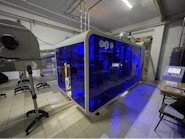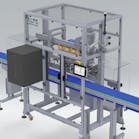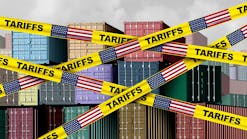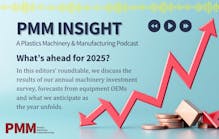More than 50 years ago, JJ Graffin developed his first weigh-filling machine for liquids in his mother’s garage. It was a highly accurate, innovative machine because, unlike other machines of that era, it was unaffected by liquid temperature variations that caused fluctuations in filling cycles.
That early innovation led him to found Serac in la Ferté Bernard in the Pays de la Loire region in northwest France in 1969. The company specializes in the design and manufacture of liquid filling and capping machines, as well as blow molding equipment. It is a leading manufacturer of liquid filling and capping machines for all types of food products, home and personal care products and industrial products.
Graffin expanded Serac by developing a blow molding machine that is integrated with its filling machines; that system provides an all-in-one bottle manufacturing and filling solution to reduce customers’ transportation costs. It created a surge in demand from several businesses, including the sports and energy drink sector.
From its modest origins 51 years ago, Serac now employs more than 600 workers in 10 countries and manufactures on four continents. Despite that vibrant growth, Graffin said he enjoys continuing to work as an engineer for the company, rather than strictly in an administrative or management capacity.
Graffin received the Nessim Habif Prize from the Society of Arts and Crafts Engineers for lifelong career achievements in 2009, and the French government granted him the National Order of Merit in 1979. He reflected on his career and on the growth and evolution of his company in an interview with Bruce Adams, senior staff reporter at Plastics Machinery Magazine.
Where did you go to university and what is your degree in?
Graffin: I earned my degree of mechanical engineer in 1959 in one of the top French colleges called ENSAM (l’École Nationale Supérieure d’Arts et Métiers).
What was your first job out of college?
Graffin: I went to Senegal and Cameroon to work for a French public works company to maintain their fleet of earth-moving machines.
When and how were you first exposed to the plastics industry?
Graffin: In 1966, I was hired as the managing director by the owner of a small company in France that manufactured dosing pumps that were used to fill milk bottles. This coincided with the arrival of the plastic bottle in the dairy market in France. The company was in a poor financial position. I started to develop a semi-automatic dairy filler for plastic bottles that was used by dairy farms and small industrial dairies.
What events or inspiration led you to found Serac in 1969?
Graffin: After achieving some success with the semi-automatic dairy filler, I started to design an automatic filler. After three years, the success of the products I developed helped to turn the company around and produce good profits. At this point, the owner asked his grandson to join and take control of the company.
Of course, I was disappointed. I decided to leave the company and create my own business. In the meantime, with the expertise that I acquired in the dairy field, I saw that the operators on the filling lines used to control the accuracy of their filled bottles with comparison scales. I thought there was a better way to fill bottles, and I worked to design a weigh filler, which fills bottles based on the weight of the liquid in the bottle rather than the volume of liquid.
What inspired you to name the company Serac?
Graffin: I did not want to use my name, so I started to look for a company name. In French, Serac means "Societe d'Etudes et de Realisation d'Appareils de Conditionnement." The closest English translation is "company of design and manufacturing of packaging machinery."
You have been credited with creating the first weigh filler in the food industry. Discuss the importance of this product to the company and to the industry.
Graffin: The huge advantage ... is that the dosing apparatus is not interfering with the product, such as with a pump. Milk is a living product with bacteria, and a filling machine must eliminate the risk of contamination.
I designed an electromagnetic nozzle with a closing ball. This design is patented. My filler had no rubber seal, only a tank with nozzles on the periphery with a stainless-steel valve. The seat and balls are actuated by a magnetic field.
Another advantage of filling by weight is the insensibility to the variation of temperature. Because liquids expand with the increasing temperature, the stroke of a volumetric machine must be adjusted accordingly to avoid spillage or under-filling.
For these reasons, the weigh filler was an immediate success. We were able to expand very quickly into other markets, including detergent, home-care products, agrochemical, lubricants and others. When I designed this in the 1970s, there was no electronic option, so I designed mechanical scales.
In the 1980s, I introduced the electronic load cells to this product. It was another breakthrough with the huge advantage of recording all the filling data on every bottle. The filler was its own checkweigher.
Serac introduced its first PET bottle blowing machine in 2012. Why did you decide to enter that business and what effect has it had on the company?
Graffin: We are in a competitive market with strong competitors proposing complete lines, including blowing the bottles. We were leaders in the dairy market, and it became obvious that to keep our leadership role, we had to come up with our own blow molding machines. The company was more than 40 years old, and it was a big challenge to enter a new business, but today I can say that we did it.
For me, this means a new dimension for my company.
Do you have a specific market niche for your PET bottle blowing business? If yes, what is it?
Graffin: The niches are first in the dairy industry for milk, dairy beverages, coffee creamers, drinking yogurt, and for cups for our division cups filler NOVA.
What are some of the other important milestones that Serac achieved through the years?
Graffin: I started from scratch, in 1969, and in 1975 we presented the first aseptic filler for milk in plastic bottles. Unfortunately, that solution was too advanced for the market at that time. We had to wait until the 1990s to see market acceptance and real benefits.
In 1982 I purchased Bertaud, a company manufacturing piston fillers for viscous products. This was old technology that we rejuvenated with a piston filler that was cleanable in place. The cylinders and pistons were located in the tank and for the cleaning we extracted automatically the piston from the cylinder and washed everything with spray balls in the tank like a dishwasher.
In your early years in business, who was your mentor? Whom did you admire and why?
Graffin: In my youth, I saw my parents running their small business for general mechanical and farm equipment. I got the virus of entrepreneurship from them.
In my early years in business, when I was working in France, I worked as a deputy manager for three years in a company manufacturing small loaders and earth-moving equipment. I learned a lot about designing, hydraulics, testing prototypes and the managing of people.
Today, I admire Elon Musk. I started to drive a Tesla in 2014 and I use Tesla solar panels with a Powerwall in my home. I also watch every SpaceX launch.
What major challenges did you encounter as your business grew?
Graffin: To hire the right collaborators.
What is the greatest challenge you faced in your business career?
Graffin: I have no recollection of a particularly great challenge. As an entrepreneur, you must be prepared for a new challenge every day. Working and collaborating with others to overcome those challenges becomes a way of life.
To what do you attribute your company’s success?
Graffin: Opiniâtre. The English translation is tenaciousness or having a tenacious habit to continue to exist and to be influential for a long time.
Do you personally hold any patents? How many patents does Serac hold?
Graffin: The patent office called me two years ago and said, “Mr. Graffin, I will deposit this patent free of charge for you. It is a gift of my office.” When I asked why I was receiving this gift, he informed me that it was my 100th patent. Today, I can tell you I have more than 100 patents. For me, the creation is cyclical. I might go two years without any new ideas and in the following year come up with three or four patents.
What is Serac working to develop now?
Graffin: We are in the process of introducing our new BluStream technology. It is decontamination by electron beams, free of any water or chemical usage. This will be at the new frontier of “green” decontamination technology in the future.
Serac is privately owned. I imagine several companies have expressed an interest in purchasing Serac. Why have you decided to keep the company privately owned rather than sell?
Graffin: Yes, many times I have received inquiries. But this is my baby and I consider it a family business that has a soul and is unique for employees and for our customers. I don’t want to lose that by selling the company.
What percent of Serac’s business is done in Europe, North America, South America and Asia?
Graffin: Forty percent in Europe, the Middle East and Africa; 30 percent in the Americas; and 30 percent in Asia.
What is your impression of Industry 4.0 and its future in the plastics industry?
Graffin: I do believe that it is necessary to balance life and well-being. We have to use new modern technologies to our advantages. We have no choice as the current generations are born with it, and it will be a non-neglectable fact of society in the future.
I surprise myself when using my Tesla app for my car and my Powerwall. When I travel overseas, I frequently watch my Tesla app to see my electricity savings. We are connected more and more, real time. It is a fact of our generations and those to come.
It is clear that there will be future Serac apps for our customers to follow their machines. Very soon, [I can envision a future in which] I will use it to follow the shipment of my first blow molder traveling to the Red Planet in a starship rocket. My only concern will be that I will not get the information in real time.
Where do you see the blow molding and plastics industry 10 or 20 years from now? How will it be different from today?
Graffin: The main difference will be in a generalized and compulsory plastics recycling initiative, with obviously more taxes to support that effort. Also, the arrival of new biodegradable materials will have an impact on the industry.
Please discuss the issue of sustainability and the company’s commitment in that area.
Graffin: We are very concerned about this. Fortunately, our kind of manufacturing includes design and assembling. We subcontract all the machining. So, our work environment is clean and noise-free. We plan to install solar panels on our plant roof.
For our customers, we are developing BluStream technology, which will be a breakthrough in the decontamination of bottles and caps. They will no longer need to use chemicals for decontamination, and this will result in a huge savings in water consumption. In the future, many resources that we now take for granted will be acquired at a premium, so we need to prepare for that. Once again, Serac will lead the way.
Do you have any hobbies?
Graffin: Yes – creation. To relieve stress, I enjoy playing the piano. When I was younger, I enjoyed piloting my own planes.
How would you like to be remembered? What legacy do you want to leave behind?
Graffin: I have never thought about this question. My legacy would be the continuation of my work by my kids. Let's dream about eternity. …
Just the facts
WHO IS HE: JJ (Jean-Jacques) Graffin, founder, owner and chief engineer at Serac
HEADQUARTERS: La Ferté-Bernard, France
COMPANY FOUNDED: 1969
EMPLOYEES: 600






